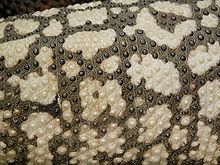- Osteoderm
-
Osteoderms are bony deposits forming scales, plates or other structures in the dermal layers of the skin. Osteoderms are found in many groups of extant and extinct reptiles, including lizards, various groups of dinosaurs (most notably ankylosaurs and stegosaurians), crocodilians, phytosaurs, aetosaurs, placodonts, and hupehsuchians (marine reptiles with possible ichthyosaur affinities).
Osteoderms are uncommon in mammals, but do occur in pangolins and many xenarthrans (glyptodonts, armadillos, ground sloths). Osteoderms have clearly evolved independently in many different lineages, and these varied structures should be thought of anatomical analogues, not homologues, and do not necessarily indicate monophyly. In many cases osteoderms may function as defensive armor.
The osteoderms of modern crocodylians are heavily vascularized, and can function as both armor and as heat-exchangers, allowing these large reptiles to rapidly raise or lower their temperature.
See also
References
- Carroll, R. L. 1988. Vertebrate Paleontology and Evolution. W. H. Freeman and Company.
This animal anatomy-related article is a stub. You can help Wikipedia by expanding it. This veterinary medicine–related article is a stub. You can help Wikipedia by expanding it.

